How to play poker
Master the basics of a typical game with our how to play poker guide. Whether you're an absolute beginner or already a big poker fan, it's always a good idea to brush up on the rules. There are numerous different variants of this popular card game, but you only need to know one or two of these before you can start playing online. In this guide, we’ll be covering:
- Poker rules, and step by step information on how to play a hand
- An overview of poker hand rankings, as well as what makes up the best poker hands
- Some key poker terminology, like limits and pot odds, and what it all means
How does poker work?
The reality is that each variation of the game, from HORSE to Omaha, has its own poker rules and gameplay quirks. Despite this, learning how to play basic poker is pretty simple. In almost every case, the aim of the game is the same: put together a stronger poker hand than your opponents.
Let’s take a look at how to play Texas Hold‘Em poker, one of the simplest and most popular variants. The five basic steps are as follows:
- 1Players are dealt their cards, and initial bets are placed
- 2Community cards are dealt, followed by a round of betting
- 3Fourth card is dealt, then another betting round
- 4Final card is dealt, then one more round of betting
- 5During the showdown, players still in the game reveal their hands
How to play poker step-by-step
We'll now take you through a more detailed version of how to play poker for beginners, again based on a game of Texas Hold 'Em. The following steps can be applied to most poker variants, but make sure you always check for any variant-specific rules before you start playing.
STEP 1
Place your bets
Before the cards are dealt, players will place their bets. These can include ante bets, where all players put in an equal amount of money, and blinds, where the player immediately to the left of the dealer places a small bet and the player to the left of them places a larger one.
Players then receive two hole (face down) cards each. At this point, players must decide if they’re going to check (decline the opportunity to start the betting), bet/call any bets (match another player's bet), or fold if they have a weak hand. Each time a player decides to check, the opportunity to bet or check is passed on clockwise to the next player. Once a player makes the first bet, all remaining players must call, to match that amount.
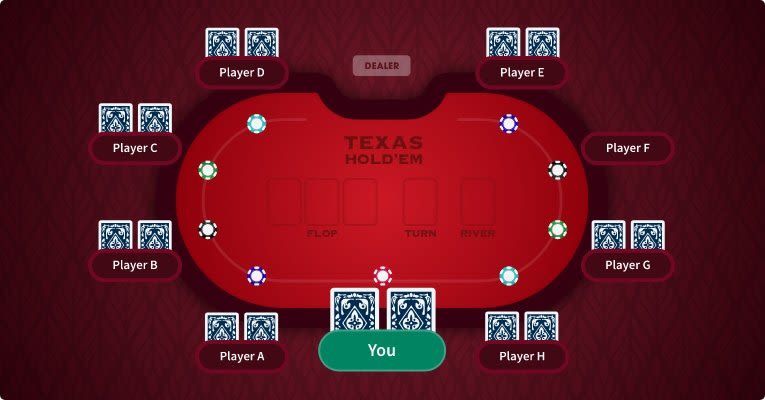
STEP 2
The community cards
Once betting has concluded, the flop (three face up cards) is dealt. Players can now get a better idea of their hand strength, and another round of betting takes place
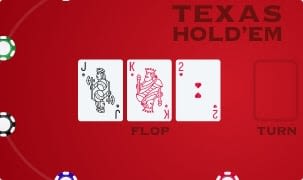
STEP 3
Time for the turn
Next, the turn (a fourth face up card) is dealt and can be used by players to build a better hand. Bear in mind that a hand consists of only five cards. This then is followed by another round of betting.
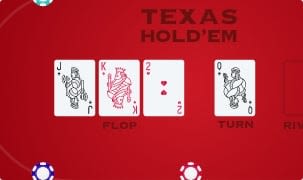
STEP 4
Hands Are Finalized
The river (a fifth face up card) is dealt, and players who are still in can see the actual strength of their hand. Before the showdown, it’s time for one final round of betting
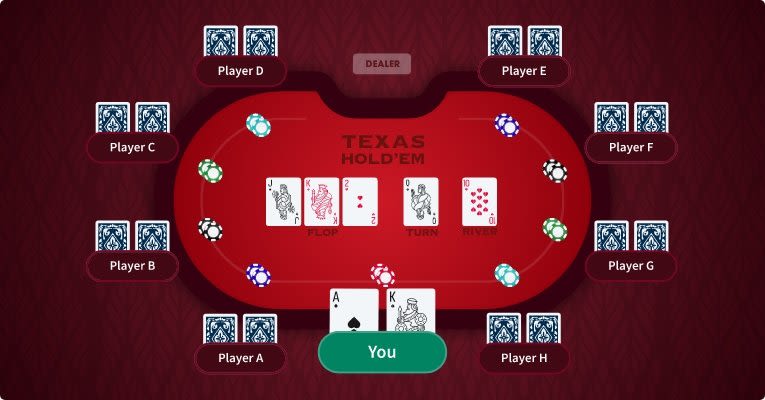
STEP 5
The Winner is revealed
Now it’s time for the showdown, when players reveal their poker hands to see who has won the pot. A kicker, the highest card, may be used to break ties.
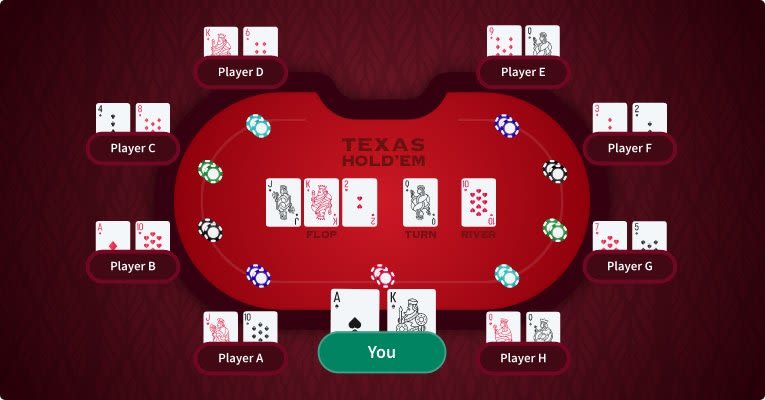
What are winning poker hands?
A - K - Q - J - 10
A, K, Q, J, and 10 all in the same suit

Q - J - 10 - 9 - 8
Five cards in sequence, all in the same suit

J - J - J - J - 3
Four cards of the same rank

J - J - 5 - 5 - 5
Three of a kind and a pair

J - 10 - 4 - 6 - 3
Any five cards in the same suit, not in sequence

6 - 7 - 8 - 9 - 10
Five cards in sequence, not in the same suit

7 - 7 - 7 - 9 - 3
Three cards of the same rank

K - K - 2 - 6 - 6
Two cards of one rank, and two cards of another

J - J - 2 - 7 - 4
A pair of Jacks, Queens, Kings or Aces

5 - 5 - 2 - 7 - 4
Two cards of the same rank

Download our poker hand rankings chart
It’s likely that you’ll start to remember the poker hand rankings very quickly as you start playing. However, many new players find it useful to keep a copy of our chart of the best poker hands by their side in the meantime. The chart will help you to decide whether you might want to call, raise your bet or fold your hand.
How to play poker in a casino
You’ll find playing poker in a real casino similar to playing online, especially if you’ve played with a live dealer before. The table set-up is the same as a virtual table, but the dealer is, of course, a real person. One key difference you’ll notice is the speed at which the game is played. Poker in a land casino is played at a much slower pace, and you can only play at one table at a time. As a result, you’ll end up playing fewer hands.
Another big difference is that you’re able to see the other players – something you can use to your advantage. By keeping an eye on their body language and playing style, you can try to figure out their next move or when they’re bluffing. It’s also a good idea to check the casino’s rules, which should be visible in the poker room. Although the basic steps for how to play still apply, you should still make sure you’re familiar with the specific variant offered by your chosen casino and any other house rules. Once you’ve done that, you’ll be ready to start playing.
What makes a good starting poker hand?
Understanding hand strengths is hugely important for becoming a better poker player.
Playing with cards that have poor poker odds is rarely a good idea. You'll most likely find yourself eating away at your bankroll as you stay in the round trying to put together a decent hand. To increase your chances of success, use the information below to recognise which hands are worth sticking with, and which to simply throw away.
Starting Hands
You'll only get two cards at the start of a hand, so make sure they're both strong. It's much easier to play a pot with a strong holding, particularly when you're starting out, as it negates any chances of getting into sticky situations. If you know you're beat even when holding a good hand, you shouldn't be in the hand - simple.
Even a new player can make a lot of money from micro and small-stake games online by playing a tight, solid, ABC game. If it's a good hand and a good situation, play it. If you know you can't win and the other player isn't going to fold, just muck your hand to fight another day.
So, what's a good starting hand?
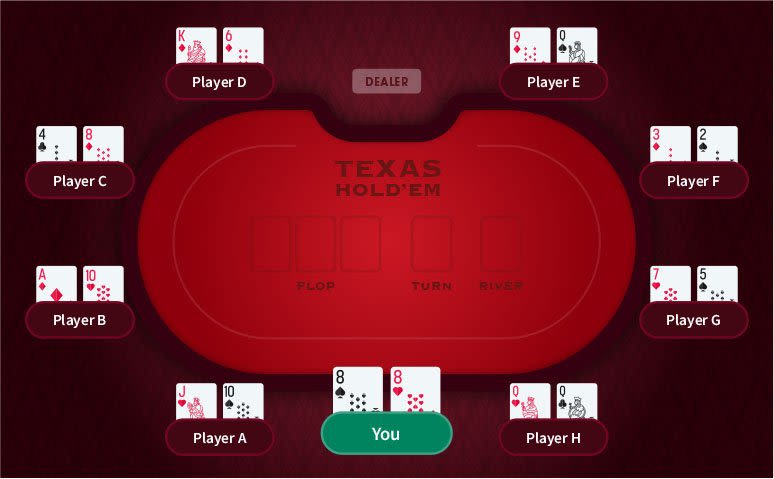
Strong Hands
Obviously, high pairs like A-A, K-K, Q-Q, J-J and 10-10 are worth raising with, particularly in late position.
A-K, A-Q and A-J, all suited, are more examples of strong hands you want to raise with pre-flop. They're also good hands for making Continuation Bets with, i.e. if you've raised pre-flop and have hit a flop that doesn't really help you (say, the three cards are all below yours) you may want to lead out with a bet to portray strength.


Medium Strength Hands
Next come the medium strength hands, like K-10, Q-10 and J-10, and medium pairs like 9-9, 8-8 and 7-7. They're all good raising hands, depending on position and the dynamic of your table, but can also be called with in an aggressive pre-flop betting round.

Marginal Hands
Finally, marginal hands like 2-2, 3-3, and A-9 are all decent hands for calling with pre-flop if in late position. You may disguise your hand by hitting trips (three of a kind) on the flop, then you can start to be aggressive.
The beauty of online poker is that no two tables are alike. If you have a particularly tight table you can mix things up by expanding your starting hand range to exploit weakness. For most beginners, however, a solid game with strong starting hands is sensible, if a little dull to start off with.

What are some basic poker rules?
Once you’re familiar with how the game is played, there are still some poker rules that you should know about before you start to play for real money in an online casino. The exact details of the rules listed below may differ between variants, but these are the typical things you should be aware of:
-
Blinds
Most forms of poker have big and small blinds. These are sums of money that must be paid by two players each hand, to boost the value of each pot. This is totally normal and isn’t something you can avoid; just hope you have a good hand when it’s your turn to pay blinds.
-
Decks
In virtually all forms of poker, a single deck of cards is used. This is to prevent bizarre hands like 5 or 6 of a kind emerging. Measures like shuffling and burning mean that players still can’t accurately predict what cards will come out next.
-
Rake
When playing in a land-based venue or in an online casino, the house will take a certain percentage of the pot or the tournament buy-in to generate profits. This figure could be anywhere between 3-10% and is completely above board and difficult to avoid.
-
Chips
The number of chips you get when you sit down at an online poker table can vary hugely. It will depend on things like table limits and whether you’re playing at a tournament or not. Check this out in advance so you don’t end up feeling like a fish out of water.
-
People
How many people can play varies slightly from casino to casino. In theory, 20+ people could play at a single Texas Hold ‘Em table. In practice, most casino/online poker sites limit tables to around 10. Any more than 10 or 12 players at a table and hands simply take too long to play out.
-
Cards
How many cards you get, and whether they’re face up or face down, varies widely depending on the poker variant you’re playing. Make sure, before you start playing, that you understand all the rules of your chosen variant.
What are pot odds?
Pot odds are the ratio of the current size of the pot to the cost of a call the player is facing. In a nutshell, pot odds can be used to help a player decide whether or not it’s a smart move to place a bet, based on the cards they need to complete a winning hand. They’re definitely worth getting familiar with as you learn about poker online.
1. For example, let's say you hold a pair of fours at the start of a hand. To hit another 4, making a set, on the flop your odds would be around 7.5 to 1. You know this because there are only two other cards you need (2 out of 52), you hold two yourself, and the other players hold two apiece.
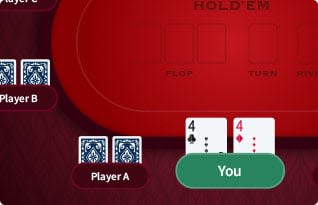
2. If you're not going to make more than 7.5 to 1 on your bet by playing, it's not worth playing; the 'pot odds' are not good enough for you to call. So, if the pot had $25 in it, and you had to bet $5, your pot odds would be 5 to 1: not enough to make the call.

3. Let's say you make the call anyway, and the flop misses you entirely, coming J-K-2. Your chances of hitting that 4 just went up, as there are fewer cards to come out. However, the action gets a bit crazy post-flop and you're being offered around 10 to 1 on your money to make a call, knowing that your hand odds are about 9 to 1. Now you DO make the call.

Putting your poker knowledge into practice
When it comes to playing poker online, we think it’s wise to arm yourself with as much knowledge as possible. We’ve covered everything from the basic rules of online poker in 2022 to poker hand rankings (including the highest hand in poker), to put you in the best position possible to start playing poker and winning. If you want to put your skills to the test, discover more about pai gow poker or poker freerolls, then take a look at the pages listed below, where we also recommend the best casinos for real money play. Good luck!




